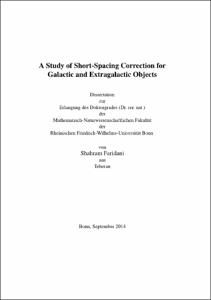A Study of Short-Spacing Correction for Galactic and Extragalactic Objects

A Study of Short-Spacing Correction for Galactic and Extragalactic Objects

| dc.contributor.advisor | Kerp, Jürgen | |
| dc.contributor.author | Faridani, Shahram | |
| dc.date.accessioned | 2020-04-20T19:46:58Z | |
| dc.date.available | 2020-04-20T19:46:58Z | |
| dc.date.issued | 11.02.2015 | |
| dc.identifier.uri | https://hdl.handle.net/20.500.11811/6409 | |
| dc.description.abstract | Radio telescopes can be divided into single-dish instruments and interferometer arrays. Their respective observational approaches are fundamentally different. Single dishes can make an accurate measurement of flux. However, due to practical limits in the size of the dish which can be constructed, they have correspondingly limited resolution. On the other hand, interferometric arrays can be as large as the earth, with corresponding resolution, yet cannot accurately measure the total flux, or resolve extended objects. This is because they are not able to measure zero- and short-spacings. The technique of short-spacing correction (SSC) bridges the gap between the single-dish and array approaches. It combines the high angular resolution from interferometric observations with the total flux measurement from single-dish observations. Hence, the final data product combines the best of both worlds. The correction is of great importance for the Galactic objects as well as a number of nearby galaxies with considerable amount of diffuse and extended structure. For neutral atomic hydrogen (HI) observations, each of these instruments provides different information regarding different gas phases present in the interstellar medium (ISM). The single-dish instrument provides information regarding the large angular scale structures, whereas the interferometric array provides information about the small angular scale structures. Only after combining the two data sets is it possible to study all gas phases in detail. In the near future, several large interferometer instruments will become available. The new instruments provide large amounts of data (for instance, in the case of the Australia’s Square Kilometer Array Pathfinder (ASKAP, Duffy et al. 2012), the expected data rate is about 2.8 GB/s). Considering the large amount of data, it is very difficult to store the raw data indefinitely. SSC will continue to be a desirable technique, and any viable SSC algorithm needs to be designed to cope with the anticipated features and problems of the new instruments. An important requirement for a future-oriented SSC algorithm is therefore that it operates on science-ready images, not requiring any raw data input. The present dissertation presents an automated pipeline which is able to perform the SSC in the image domain. The algorithm takes the peculiarities of future instruments into account, namely, large amounts of data and restricted access to raw data. It operates on cleaned and calibrated interferometric data in combination with single-dish observations. The impacts on the algorithm of weighting schemes and pixel size in combination with different deconvolution procedures have also been studied. The latter parameters were found to affect the result of the combination significantly. The pipeline has been evaluated with both Galactic and extragalactic spectral line data sets obtained from different instruments. In all the cases, the combination fulfills the expectations, i.e., the measured total flux in the combined data set is in good agreement with the measured value in the single-dish data, while the interferometric resolution is preserved in the combination. The study underlines the importance of SSC for a detailed study of different gas phases. | en |
| dc.language.iso | eng | |
| dc.rights | In Copyright | |
| dc.rights.uri | http://rightsstatements.org/vocab/InC/1.0/ | |
| dc.subject | Radioastronomie | |
| dc.subject | Signalverarbeitung | |
| dc.subject | Gasphasen | |
| dc.subject | Neutraler Wasserstoff | |
| dc.subject | Bildverarbeitung | |
| dc.subject | Single Dish | |
| dc.subject | Interferometer | |
| dc.subject | Hochgeschwindigkeitswolken (HVCs) | |
| dc.subject | interstellare Materie (ISM) | |
| dc.subject | kinematics and dynamics of galaxy | |
| dc.subject | neutral atomic hydrogen (HI) | |
| dc.subject | image processing | |
| dc.subject | Small Magellanic Cloud (SMC) | |
| dc.subject | high-velocity clouds (HVCs) | |
| dc.subject | single dish | |
| dc.subject | interferometer | |
| dc.subject | interstellar medium (ISM) | |
| dc.subject.ddc | 520 Astronomie, Kartografie | |
| dc.title | A Study of Short-Spacing Correction for Galactic and Extragalactic Objects | |
| dc.type | Dissertation oder Habilitation | |
| dc.publisher.name | Universitäts- und Landesbibliothek Bonn | |
| dc.publisher.location | Bonn | |
| dc.rights.accessRights | openAccess | |
| dc.identifier.urn | https://nbn-resolving.org/urn:nbn:de:hbz:5n-38995 | |
| ulbbn.pubtype | Erstveröffentlichung | |
| ulbbnediss.affiliation.name | Rheinische Friedrich-Wilhelms-Universität Bonn | |
| ulbbnediss.affiliation.location | Bonn | |
| ulbbnediss.thesis.level | Dissertation | |
| ulbbnediss.dissID | 3899 | |
| ulbbnediss.date.accepted | 19.12.2014 | |
| ulbbnediss.institute | Mathematisch-Naturwissenschaftliche Fakultät : Fachgruppe Physik/Astronomie / Argelander-Institut für Astronomie (AIfA) | |
| ulbbnediss.fakultaet | Mathematisch-Naturwissenschaftliche Fakultät | |
| dc.contributor.coReferee | Kroupa, Pavel |
Dateien zu dieser Ressource
Das Dokument erscheint in:
-
E-Dissertationen (4381)




